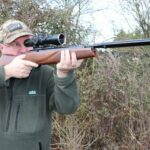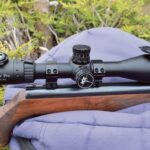
(Michael Anschuetz photo)
There was a time when Remington’s Model 760 slide action and Model 742 autoloader in .30-06, .270 Winchester, and other popular cartridges ranked among the best-selling rifles in America. This caused much agony and embarrassment among Winchester executives because their company had not a single quick-shooting firearm capable of competing against those two. The Model 94 lever action was still being built, but the grand old .30-30 cartridge was short on horsepower when stacked against its competition. The time to introduce rifles capable of racing neck-to-neck with the two Remington thoroughbreds was upon them. Winchester’s eventual answer to the Remington 742 was the gas-operated Model 100, and one of the chamberings was the rebated-rim .284 Winchester.
The company had never built a slide-action centerfire rifle, but decades of successful lever actions prompted development of the Model 88 lever action. Due to rotating locking lugs at the front of its bolt, Winchester described it as “the bolt-action rifle with a lever.” Unlike the separate buttstock and forearm of Remington rifles, both new Winchesters had a one-piece stock. Like the Remington rifles, they fed cartridges from a detachable box magazine. Both were introduced in .243 Winchester and .308 Winchester, and the company eventually necked up the .308 case and offered the .358 Winchester in the Model 88 only. The .308 came close enough to matching the performance of the .30-06 in the two Remington rifles, but Winchester technicians had to put on their thinking cap and work hard in order to duplicate the performance of the .270 Win. and .280 Rem. in a cartridge short enough to work in the new rifles.

The Terrific .284 Win.
The .308 Win. case necked down for 0.277-inch and 0.284-inch bullets was tried, but maximum velocity was a bit shy of the .270 Win. and .280 Rem. A cartridge with more powder capacity was needed, and since the magazines of the Winchester rifles did not allow going longer, the engineers decided to go wider. The .284 Winchester case they came up with in 1963 has the same rim diameter as the .308 Win. and a body diameter a mere 0.013 inch smaller than the .300 Winchester Magnum. The case has only 0.025 inch of body taper and is 0.155 inch longer than the .308 case. Its 35-degree shoulder angle was quite radical at the time.
Winchester ammo was loaded with 125- and 150-grain Power-Point bullets at respective advertised velocities of 3,200 and 2,900 fps. At the time, the .280 Rem. was loaded with bullets of the same weights at those exact same velocities. Claimed velocities for the .270 Win. with 130- and 150-grain bullets were 3,140 and 2,900 fps, so the .284 Win. was up to speed there as well.
The Speer Reloading Manual No. 10, published in 1979, has data for the .284 Win. fired in the 22-inch barrel of a Ruger Model 77 rifle, and maximum velocities with 130- and 145-grain bullets were 3,111 and 3,006 fps. From the 24-inch barrel of a Remington Model 700, maximum velocities for bullets of those weights from the .280 Rem. were 3,106 and 2,976 fps. So, with bullet weights commonly used in both cartridges, there was very little difference in their performance.
That did not hold true for heavier bullets because when seated for the magazine of a short-action rifle, they occupied space inside the case that could have been used for powder, and velocity suffered a bit. With the Speer 160-grain and 175-grain bullets loaded in both cartridges, respective maximum velocities were 2,808 fps and 2,717 fps for the .284 Win. and 2,893 fps and 2,767 fps for the .280 Rem. While the .280 Rem. had a velocity edge with the heavier bullets, the difference was not enough to matter, even on game as large as moose and elk.

We now move forward about four decades to Hodgdon’s 2018 Annual Manual, the last year in which the .284 Win. was included. Using 24-inch pressure barrels, maximum velocities for the .284 Win. with 130-, 140-, 150-, and 160-grain bullets are 3,130, 3,079, 2,968, and 2,864 fps respectively. There is no 130-grain bullet listed for the .280 Rem., but maximums for 140-, 150-, and 160-grain bullets are 2,983, 2,822, and 2,773 fps. Both cartridges are loaded to about the same chamber pressures, and again, the .280 Rem. pulls ahead only when loaded with a 160-grain bullet. Even more interesting, Hodgdon lists maximum velocity of a 140-grain bullet from the .280 Ackley Improved as 3,068 fps versus 3,079 fps for a bullet of the same weight from the .284 Win. Who says the .284 Win. has outlived its useful life as a big-game cartridge?
Winchester may have missed the boat by not offering the .284 Win. in the Model 70 Featherweight. I say this because Melvin Forbes of Ultra Light Arms proved there was considerable demand for the cartridge in a lightweight, bolt-action rifle by building more of his Model 20s in .284 Win. than any other caliber. The one I used to take a very good mule deer in Montana drove tacks and carried like a feather. Ruger offered the .284 Win. in the Model 77, but not many were made. Model 70s in .284 Win. built by U.S. Repeating Arms are also quite scarce. Browning rifles built on a Sako action were available, and while A-Bolt rifles were also chambered for it, I have never spotted one. What I have seen is a saddle-worn Savage 99 in .284 Win. owned by a Wyoming rancher friend who had used it to take 32 elk along with a bunch of mule deer and antelope. (A few Savage 110s also may have been chambered for the cartridge.)
My favorite .284 Win. was built in 1984 by Alpha Arms where the cartridge was a top seller for many years. The Custom model with a blued steel barreled action and a nicely figured walnut stock has a 21.5-inch barrel with a 1:9 twist. It weighs 6 pounds, 14 ounces with a compact 3-9X scope in a Buehler two-piece mount. The rifle is on what was described as a short action, and while it is shorter than the action made by Alpha Arms for .30-06-length cartridges, it is 0.250 inch longer than the Remington Model 700 short action. Interior length of its magazine is 3.070 inches, and for trouble-free feeding of cartridges, I keep maximum cartridge overall length at 3.050 inches. The chamber throat is long enough to handle various bullets seated to that length. My name was engraved on the barrel, and it will be one of the very last rifles I part with.

Some reloading manuals adhere to the SAMMI maximum cartridge length of 2.800 inches for the .284 Win., but others do not. Cartridge lengths in the 10th edition Hornady load manual range from 2.905 inches to 2.995 inches. Those in the Hodgdon 2018 Annual Manual range from 2.800 inches to 2.990 inches. Cartridge lengths exceeding the SAAMI maximum are included because the .284 Win. is now used not only in rifles with short magazines, but also in rifles with .30-06-length magazines custom built for hunting and competitive shooting. Beginning with a published starting load and carefully working up is always important, especially so when handloading the .284 Win. for a short-magazine rifle and using data developed for long-magazine rifles.
Handloading Hints
Some of the medium-weight bullets we have today perform as well on larger game as heavier weights of older designs, and they take up less space inside the .284 Win. case. I would not hesitate to take on the biggest elk or moose in the woods with the Hornady 139-grain GMX or 140-grain bullets like the Barnes TSX and Swift A-Frame at velocities from 2,900 to 3,000 fps.
With that said, I will confess to having taken more whitetail deer, mule deer, pronghorn antelope, and caribou with the .284 Win. loaded with the Speer 130-grain Spitzer boattail than with any other bullet. An antelope in Wyoming in 1984 was the very first game I took with an Alpha Arms rifle, and it fell at a distance of 260 yards when struck behind the shoulder with the Speer bullet loaded to 3,100 fps. That particular rifle was a loaner, and it was the Grand Slam model with a laminated wood stock. In it and in the Custom model I still have, the Speer 130-grain boattail carves smaller groups than its flatbase mate, but both are accurate enough to take game as far away as I care to attempt.
Soon after the .284 Win. was introduced, wildcatters raced to their loading benches and necked the case up and down to various bullet diameters, and Alpha Arms offered several of them. After the dust settled, the 6mm-284 and .25-284 emerged as not only the most popular, but the 6mm went on to outshine the .284 Win. as well. I still have rifles chambered for both. Back then, the 6.5-284 got very little attention, but you know the rest of its story.
When necking down .284 Win. cases for 6.5mm bullets years ago, it did not dawn on us that Winchester brass would eventually become extremely difficult to find, and we would someday be necking up 6.5-284 brass available from Lapua and Hornady for .284 Win. rifles. The RCBS expander die with a tapered 7mm expander I use opens up the neck of a case a bit too much for adequate neck tension on a seated bullet, and a trip through a .284 Win. full-length resizing die is required. Another option is to replace the standard expander button of a full-length resizing die with a tapered button available from Hornady, Redding, and RCBS for their dies. Either way, a thin coat of Redding or Hornady sizing die wax applied to the inside of a case neck makes the job go more smoothly.

Shortly before completing this report, I learned that Lapua is now making match-grade .284 Win. cases. If you’re wondering why, it’s due to the availability of ultra-high-ballistic-coefficient 180-, 184-, and 190-grain bullets from Berger and 180- and 190-grain bullets from Hornady that have caused F-Class competitors to give the old .284 Win. a fresh try.
During the past dozen years or so, rifles chambered for the original .284 Win. as well as the .284 Shehane have set new records in the sport. With the exception of a mere 0.010 inch less body taper, the Shehane version is identical to the case originated by Winchester. Maximum velocities with 180- and 190-grain bullets from barrels ranging in length from 30 to 32 inches are in the 2,800- to 2,950-fps range. In 2018 Norm Harrold used a rifle in .284 Shehane to shoot a 20-shot record score of 200-22X at 1,000 yards. In F-Class competition, 200-20X is a perfect score, but a competitor who shoots a clean target can keep on firing until one of his bullets lands outside the 5-inch X-ring, hence the two additional Xs in Harrold’s score. He used Lapua 6.5-284 cases necked up and Berger 184-grain F-Open Hybrid Target bullets.
In an age when a new whiz-bang cartridge touted as the answer for everything from dandruff to fallen arches is introduced about every other week, not much outside of competitive shooting circles is heard or read about the .284 Win. these days. But take it from someone who was there during its birth, the old cartridge is capable of cleanly taking any hoofed animal in North America and most in other countries as well. And as proven by accomplished F-Class competitors, it is capable of delivering record-shattering accuracy when fired in a super-accurate rifle.
Did I already say the .284 Winchester was introduced about 50 years before its time?
















































